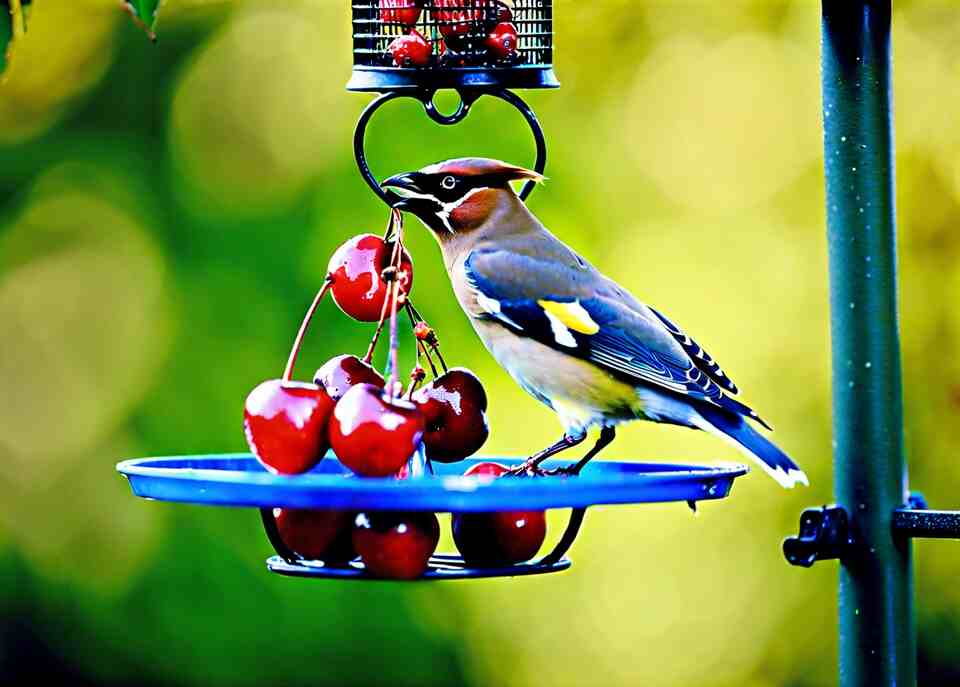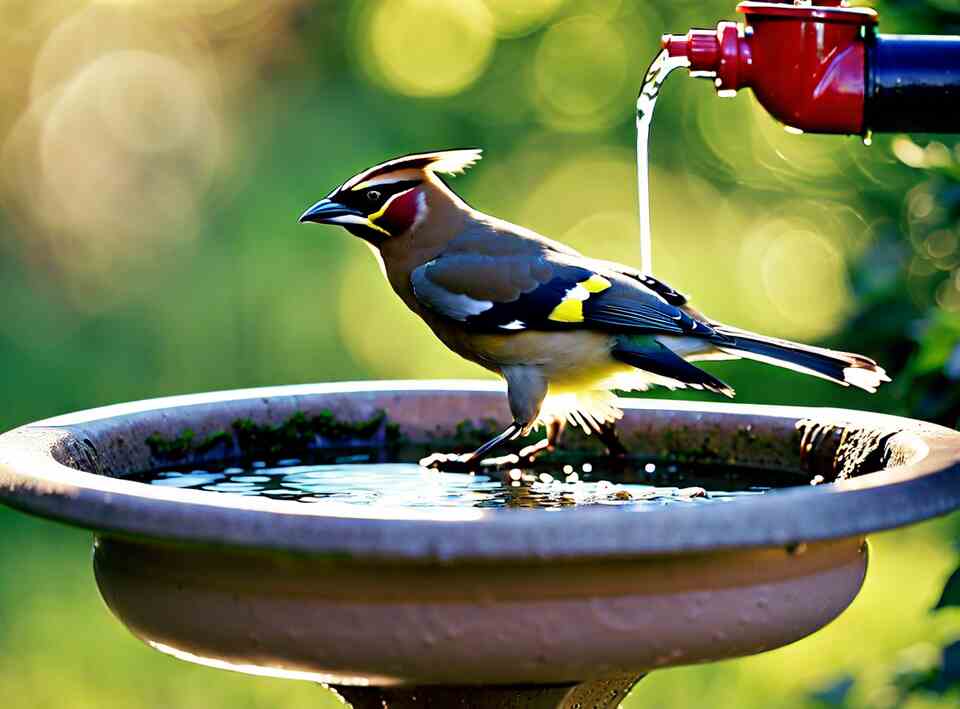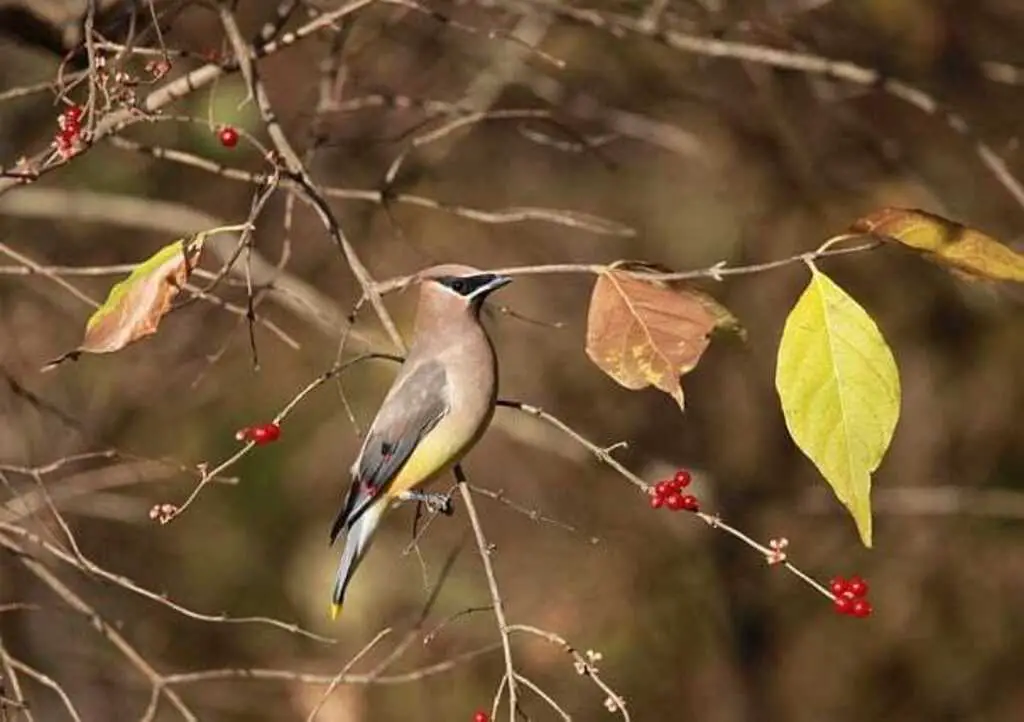
Want to liven up your yard with some feathered friends? Well, today’s all about the Cedar Waxwings – those charming birds with stylish looks! I’ve got some simple tricks up my sleeve to make them feel right at home in our yard. So, grab a seat, and let’s turn our outdoor space into a buzzing hotspot for these delightful creatures!
Table of Contents
- 1 Bringing Cedar Waxwings to Your Yard: Proven Strategies and Attractants
- 2 Identifying and Observing Cedar Waxwings: A Birdwatcher’s Guide
- 2.1 Discovering the Allure of Cedar Waxwings: A Birdwatcher’s Delight
- 2.2 Identifying the Distinctive Cedar Waxwing
- 2.3 Creating a Waxwing-Friendly Habitat
- 2.4 Providing a Reliable Food Source
- 2.5 Observing the Captivating Behaviors of Cedar Waxwings
- 2.6 Timing Your Waxwing Encounters
- 2.7 Capturing the Beauty of Cedar Waxwings
- 2.8 Appreciating the Cedar Waxwing’s Role in the Ecosystem
- 3 Conclusion
- 4 Author
Key Takeaways:
- Provide a variety of native fruits, such as berries and cherries, to attract Cedar Waxwings.
- Create a welcoming habitat with suitable trees and shrubs for nesting and roosting.
- Install a birdbath or shallow dish for water, as Cedar Waxwings are attracted to both food and water sources.
- Minimize pesticide use in your yard to maintain a healthy environment for Cedar Waxwings and their food sources.
- Regularly maintain and clean your bird feeders and water sources to ensure they remain attractive to Cedar Waxwings.

Bringing Cedar Waxwings to Your Yard: Proven Strategies and Attractants
The arrival of cedar waxwings in your yard can be a delightful sight, as these beautiful birds with their distinctive crest and vibrant plumage bring a touch of natural beauty to your outdoor space. Attracting these charming visitors, however, requires a strategic approach. In this article, we’ll explore proven strategies and effective attractants to invite cedar waxwings to take up residence in your yard.
Providing the Right Food Sources
One of the most effective ways to attract cedar waxwings is by offering them their preferred food sources. These birds are particularly fond of berries, and planting berry-producing shrubs and trees can be a game-changer. Some excellent choices include:
- Junipers: These evergreen shrubs produce clusters of small, blue-green berries that cedar waxwings adore.
- Crabapple trees: The small, tart apples that crabapple trees produce are a favorite of these birds.
- Serviceberry bushes: Also known as Juneberry, these shrubs offer a bounty of sweet, purple-black berries.
- Hawthorn trees: The bright red berries of hawthorn trees are irresistible to cedar waxwings.
In addition to these natural food sources, you can also offer supplementary feeders filled with fresh, high-quality berries or even grape jelly. While Cedar Waxwings are social birds and may be attracted to feeders, they are not as reliant on them as some other bird species.
Providing a platform feeder with chopped fruits like apples or berries can also help increase your chances of attracting these beautiful birds to your yard. Placing multiple feeders around your yard will further enhance the chances of attracting a flock.
Creating a Welcoming Habitat
Aside from providing food, creating a welcoming habitat is crucial for enticing cedar waxwings to your yard. These birds prefer areas with a mix of dense vegetation and open spaces, as this allows them to perch and take flight with ease.
Consider planting a variety of native trees and shrubs that offer both cover and access to the sky. Evergreens like junipers, as mentioned earlier, can provide year-round shelter, while deciduous trees like maples and elms offer dappled shade and perching spots.
Incorporate water sources, such as a birdbath or a small, shallow pond, as cedar waxwings are drawn to areas with a reliable water supply. Be sure to keep the water clean and regularly refreshed to maintain its appeal.
Timing Your Attractants
Understanding the seasonal movements of cedar waxwings can also help you time your attractants effectively. These birds are migratory, with their peak activity periods varying depending on your geographic location.
In many regions, cedar waxwings are most abundant during the spring and fall, as they pass through on their way to and from their breeding grounds. Pay attention to the arrival and departure of these birds in your area, and adjust your efforts accordingly.
For example, you might want to have your berry-producing plants and feeders ready before the birds arrive in the spring, ensuring a steady food source as they make their way north. Similarly, maintaining your attractants throughout the fall can help retain a flock of cedar waxwings in your yard during their southward migration.
Patience and Persistence
Attracting cedar waxwings to your yard may not happen overnight, as these birds can be somewhat unpredictable in their movements and preferences. Be patient and persistent in your efforts, as it may take time for the birds to discover and become accustomed to your yard.
Regularly monitoring your attractants and making adjustments as needed can help increase your chances of success. Additionally, sharing your experiences and insights with other bird enthusiasts can provide valuable tips and inspiration.
By following these proven strategies and incorporating the right attractants, you can transform your yard into a haven for the captivating cedar waxwing, bringing the beauty and grace of these remarkable birds right to your doorstep.
Identifying and Observing Cedar Waxwings: A Birdwatcher’s Guide
Discovering the Allure of Cedar Waxwings: A Birdwatcher’s Delight
Cedar waxwings, with their striking plumage and graceful movements, have captivated the hearts of birdwatchers for generations. These vibrant, social birds are a true delight to observe in their natural habitats, and with a bit of knowledge and patience, you can attract them to your own backyard.
Identifying the Distinctive Cedar Waxwing
The cedar waxwing is easily recognizable by its sleek, cinnamon-colored body, black mask, and distinctive crest. Their wings feature a bold yellow band, and their tails are often tipped in bright yellow as well. These birds are known for their fondness for berries and fruits, which they consume with an elegant, almost delicate manner.
Creating a Waxwing-Friendly Habitat
To attract cedar waxwings to your yard, it’s essential to provide the right environment. These birds thrive in areas with a diverse array of berry-producing plants, such as juniper, cedar, hawthorn, and serviceberry bushes. Planting these native species not only creates an inviting habitat but also supports the local ecosystem.
Providing a Reliable Food Source
In addition to the natural berries, you can supplement the waxwings’ diet by offering a variety of fruits. Hang ripe bananas, grapes, or even suet cakes in your yard to entice these feathered visitors. Additionally, consider placing a platform feeder with chopped fruits like apples or berries to provide an alternative feeding option for Cedar Waxwings. Remember to keep the feeders clean and well-stocked to ensure a consistent food source.
Observing the Captivating Behaviors of Cedar Waxwings
Once you’ve established an attractive environment, sit back and watch the cedar waxwings in action. These birds are known for their fascinating social behaviors, often forming large flocks that move in a synchronized, undulating flight pattern. Observe as they perch delicately on branches, gently plucking berries and passing them to one another in a display of cooperation.
Timing Your Waxwing Encounters
Cedar waxwings are typically most active during the spring and fall months, when they are migrating to and from their breeding grounds. Keep a sharp eye out during these seasons, as the flocks may stop to refuel in your yard. In some regions, you may even be able to spot them throughout the year, depending on the availability of their preferred food sources.
Capturing the Beauty of Cedar Waxwings
For the avid birdwatcher, photographing cedar waxwings can be a rewarding challenge. Their vibrant colors and elegant movements make them a photogenic subject. Be patient, use a telephoto lens, and try to capture them in natural settings, such as perched on a berry-laden branch or in flight.
Appreciating the Cedar Waxwing’s Role in the Ecosystem
Beyond their aesthetic appeal, cedar waxwings play an important role in the natural world. As they consume berries and fruits, they help disperse the seeds, aiding in the regeneration of the local plant life. By providing a habitat and food source for these remarkable birds, you’re not only enhancing your own backyard experience but also contributing to the overall health of the ecosystem.
Discovering the allure of cedar waxwings is a true delight for birdwatchers of all skill levels. By creating a welcoming environment and understanding their behaviors, you can invite these captivating creatures to your own backyard, where you can observe their beauty and appreciate their ecological significance. So, grab your binoculars, keep an eye out for those vibrant feathers, and enjoy the enchanting presence of the cedar waxwing.

Conclusion
Attracting the stunning and charismatic cedar waxwing to your backyard is a rewarding endeavor that can transform your outdoor space into a vibrant avian haven. By understanding their dietary preferences and providing the right mix of natural food sources, you can create an inviting environment that will entice these elegant birds to visit and even make your yard their seasonal home.
The key to successfully drawing in cedar waxwings lies in strategically selecting and cultivating the plants and trees that offer their preferred berries and fruits. Native shrubs like serviceberry, juniper, and viburnum are excellent choices, as they provide a reliable and abundant food supply throughout the seasons when these birds are most active. Supplementing your landscape with other berry-producing plants, such as pyracantha, holly, and Virginia creeper, can further enhance the allure and ensure a continuous source of sustenance.
In addition to the right vegetation, offering a reliable source of fresh water is also crucial. Birdbaths, shallow dish fountains, or even a gently moving stream can provide the hydration cedar waxwings require, especially during the drier months. Keeping these water features clean and free of debris will make them all the more appealing to these discerning visitors.
Observing the behaviors and patterns of cedar waxwings can be a captivating experience for any birdwatcher. These social and gregarious birds often travel in large flocks, making their presence known with their distinctive trilling calls and graceful, synchronized movements. Identifying them by their striking plumage, which features a sleek crest, velvety-brown back, and distinctive yellow-tipped tail feathers, can be a rewarding challenge.
Learning to recognize the cedar waxwing’s unique feeding habits can also enhance your ability to spot them in your yard. These birds are known for their elegant “waxwing” technique, where they delicately pluck berries and fruits from the tips of branches, often in a coordinated dance with their flockmates. Keeping a close eye on your berry-laden plants can increase the chances of witnessing this mesmerizing behavior.
Attracting cedar waxwings to your outdoor space requires patience and a deep appreciation for these remarkable birds. By incorporating the right mix of native plants, providing a reliable water source, and understanding their behaviors, you can transform your yard into a haven that these feathered visitors will eagerly seek out, year after year. The joy of observing their graceful movements and listening to their enchanting calls will undoubtedly enrich your birdwatching experience and deepen your connection to the natural world around you.
In the end, the effort invested in creating a cedar waxwing-friendly environment pays dividends in the form of a vibrant and dynamic backyard ecosystem, where these stunning birds can thrive and bring a touch of natural wonder to your daily life. So embrace the challenge, unleash your creativity, and let your yard become a sanctuary that attracts these avian gems, transforming your outdoor space into a true haven for both you and the wondrous cedar waxwings.



